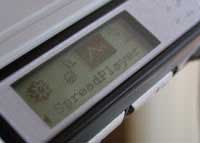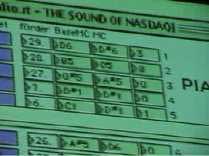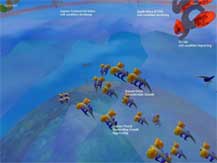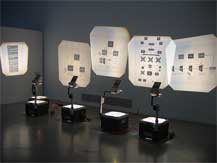Derivart is an interdisciplinary art group located in Barcelona. So far, so good. But what makes them unique is that their work focuses on the intersection between art, technology and finance.
Jesús RodrÃguez is a plastic artist, Daniel Beunza is an economic sociologist and Mar Canet is an interactive designer. Their own works blend together the intimidating fields of technology and finance and turn them into installations and devices which are both playful and accessible.
The Etch-a-Sketch toy meets real-time stock price charts in their FinanceSketch installation and SpreadPlayer translates concepts used in finance into auditive ideas such as frequency and volume. For this project, an MP3 player displays variations in prices of specific stocks, as well as fluctuation in indices in real time. You can modify the sound output with the “melody� tool (which changes the average price of a stock), cancel the “noise� of a stock (eliminating its financial peaks) or calculate an average of the up and down movements.

 SpreadPlayer and FinanceSketch
SpreadPlayer and FinanceSketch
The Barcelona trio has recently opened and curated an exhibition called “Derivatives, new art financial visions” at the Casa Encendida in Madrid (images of the opening). As you might expect, it gathers works that deal with Finance Art and explore issues such as representation and the way it mediates action; interactivity in a financial context and a critical analysis of financial capitalism.
The works are subdivided into three groups of context. First one, called re-presentación goes beyond the limits of financial representation to deal with non-financial themes. Pieces that belong to this group include Richard Rogers, Govcom.org, Natalie Jeremijenko and the Bureau of Inverse Technology. The second group, re-visión, proposes new artistic perspectives on markets with pieces by Ben Rubin, John Klima, Lisa Autogena, Joshua Portway and Fabio Ciffariello. A last group, replanteamiento, collects various critics to capital markets. This selection features works by Josh On, Lizvix and Hans Bernhard and Antoni Muntadas.

 Lise Autogena & Joshua Portway: Black Shoals Stock Market Planetarium and Fabio Cifariello: the Sound of Nasdaq
Lise Autogena & Joshua Portway: Black Shoals Stock Market Planetarium and Fabio Cifariello: the Sound of Nasdaq
All this got me very intrigued and i asked Mar Canet if between their show, their projects and his own work as interactive designer and adjunct professor at the Escuela Superior de Diseño, he could find some space to answer a few questions.
Your website says that your work is “located at the intersection between art, technology and finance.” That’s a very unusual combination. Can you tell us how and why you came to be interested in that subject?
We believe contemporary art should engage with the social problems and realities that surround us. In this sense, we believe that the capital markets embody like no other institution the economy of information, technology and flat organizations that defines our age. We came to be interested in this through different paths – mass market consumption, the visualization of large volumes of information, and the sociology of financial markets.
Derivart is Jesús RodrÃguez, a plastic artist, Mar Canet, interactive designer, and Daniel Beunza, economic sociologist. It looks like the perfect mixture of knowledge to investigate art, technology and finance. Are your respective roles inside the project very well defined? Isn’t it sometimes difficult to understand each other when you have such different backgrounds? How do you balance your respective influences?
Our group follows the same guidelines as high-tech innovative companies do, such as Google, Apple, etc. First, it is absolutely horizontal – there are no superiors and subordinates. Second, we transgress disciplinary boundaries among ourselves. Third, we are in almost-constant brainstorming mode. The key to all this is mutual respect. David Stark, a sociologist from Columbia University, calls this “organized diversity”.
Each of you seem to have his own job, does it leave you with much time to dedicate to your art group? How do you manage to be so active?
No big secret here – fewer hours of sleep! Work on Sundays.

 John Klima: Ecosystm and Ubermorgen, Alessandro Ludovico & Paolo Cirio: GWEI (image)
John Klima: Ecosystm and Ubermorgen, Alessandro Ludovico & Paolo Cirio: GWEI (image)
You have curated the first exhibition of finance art in Madrid. Can you tell us a few words about the pieces you selected?
All the pieces are chosen to make people say to themselves: “Wow, I did not know finance could be so interesting”. One first group reuses financial representations for non-financial purposes: the stock ticker becomes a tool for activism, or the Dow Jones index a barometer of social despondency.
Another group projects powerful new images: the market as a planetarium, as a videogame, as a flock of birds, as an orchestra. And finally, a third group critiques elements of the markets: bubbles, the foreign exchange commissions charged by banks, etc.
Do you think people who work in the world of finance could learn something from that show? Or is it solely oriented to art lovers?
Absolutely. We intend to be multivocal. For that reason, we organized a seminar with four professors of finance and four of the exhibiting artists. It was a real hit: it was meant to last four hours, and the participants spent seven and a half, exchanging emails and documents.
Would you define Madrid as an emerging centre of creativity? Would you advise new media artists or other people who explore emerging technologies in a creative way to come to the Spanish capital?
Spain is a happening place. The museum where we exhibit in Madrid is in Lavapies, what used to be one of the worst areas of Madrid. Now, it’s a beautiful 17th Century neighborhood replete with internet cafes, libraries, and inexpensive fix-price restaurants. Of course, we like Barcelona, our home town, even better. It has the CCCB. It’s become a capital of new media festivals – with Loop, Offf, Sonar, and Art Futura. we find fully connected to the events taking place in Europe and the States.
Can you give us the name of artists who deserve to get more attention from the public?
Here’s an artist that we have discovered as Derivart. We love the financial embroideries of Marion Charreau – she presents very personal themes, like emotion and reddening of cheeks, or season and the ripening of herbs; with a very modern, quantitative treatment.
Derivatives, new art financial visions/Derivados, Nuevas Visiones Financieras is open until September 3, at the Casa Encendida in Madrid.
If you read spanish, don’t miss Cristina Diaz’ excellent interview and article about Derivart.
